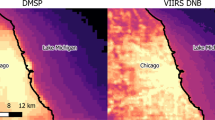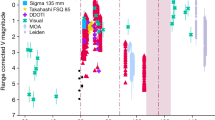Abstract
ON December 15 a photograph of the satellite 1957 Beta was taken at the Warner and Swasey Observatory of the Case Institute of Technology, Cleveland, Ohio, which shows the satellite coming out of the Earth's shadow (Fig. 1). This observation can be used for deriving the distance of the satellite from the Earth's surface. It was concluded from visual observations made the previous morning that the satellite should leave the Earth's shadow in the constellation Ursa Major. An exposure, therefore, was started at 5h. 10m. OOs. E.S.T. with Ursa Major in the centre of the field, although the satellite was not yet visible. The satellite was first observed visually between 5h. 10m. 20s. and 5h. 10m. 30s. It is estimated that it came out of the shadow not earlier than 5h. 10m. 10s. The position where the track is first recorded on the photograph is α = 11h. 53m., δ = + 54.8°. It is possible that the satellite at this position had already left the shadow, but was not recorded earlier because it was at minimum brightness. Nevertheless, since the period of light variation was about 40 sec., the real position should be between the value already given and α = 11h. 37m., δ = + 61°. From these two positions, heights above the surface of 770 and 800 km. respectively were derived, assuming a spherical Earth and a cylindrical shadow with a radius equal to that of the Earth. If refraction isrtaken into account, smaller values of the height result. Assuming a deflexion of the light rays from the Sun of 1°, the corresponding heights are 713 and 739 km. It would appear then that the derived value of 785 ± 15 km. is a maximum one. From predictions of the Smithsonian Institution a height of about 1,000 km. was expected. According to our observations this is too large by at least 200 km.
This is a preview of subscription content, access via your institution
Access options
Subscribe to this journal
Receive 51 print issues and online access
$199.00 per year
only $3.90 per issue
Buy this article
- Purchase on Springer Link
- Instant access to full article PDF
Prices may be subject to local taxes which are calculated during checkout
Similar content being viewed by others
Author information
Authors and Affiliations
Rights and permissions
About this article
Cite this article
NECKEL, H. A Photographic Observation of the Satellite 1957 Beta leaving the Earth's Shadow. Nature 181, 257–258 (1958). https://doi.org/10.1038/181257a0
Issue Date:
DOI: https://doi.org/10.1038/181257a0
Comments
By submitting a comment you agree to abide by our Terms and Community Guidelines. If you find something abusive or that does not comply with our terms or guidelines please flag it as inappropriate.



